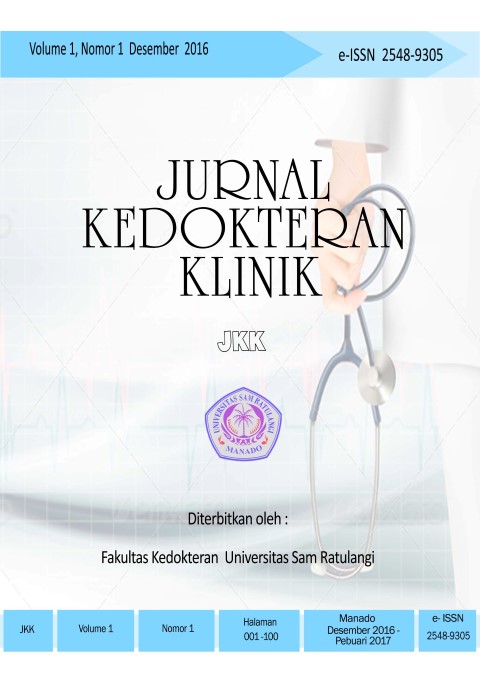HUBUNGAN ANTARA KADAR KLORIDA DENGAN TEKANAN DARAH PADA REMAJA DIKECAMATAN BOLANGITANG BARAT KABUPATEN BOLAANG MONGONDOW UTARA
Abstract
Abstract
Introduction: According to WHO’s data, globally, around 972 million people or 26,4% of earth inhabitant are suffering from hypertension. Of these 972 people, 333 millions live in developed countries and the rest of it, 638 million people, live in developing countries, including Indonesia. In Indonesia, hypertension in children and adolescents aged twenty reaches 6,1%. WHO defines adolescents as those aged 10-24 years old. One of the chloride source is salt. Salt contains 40% sodium and 60% chloride. The excessive salt intake can affect the blood pressure and the chloride levels in blood. Methods: This analytic survey study is conducted with a cross sectional design. Afterward, the collected data was processed with the help of SPSS software. The population is all of the students in SMAN1 Bolangitang Barat, North Bolaang Mongondow regency, and the samples were collected using total sampling technique. Result: From 60 respondents obtained normal diastolic blood pressure there are 47 people (78%), hypertention degrees 1 there are 11 people (18%) and hypertention degrees 2 there are 2 people (3%). Chloride levels obtained normoklorinemia there are 55 people (92%) and hyperklorinemia there are 5 people (8%). With the correlation test to significance test 95% (α < 0,05) obtained no connection between chloride levels with blood pressure α > 0,05. Conclusons: there is no correlation between levels of chloride and blood pressure on adolescents in West Bolangitang district, North Bolaang Mongondow regency.
Keywords: Chloride, Blood Pressure, Adolescents
Â
Abstrak
Pendahuluan: Menurut data WHO, di seluruh dunia, sekitar 972 juta orang atau 26,4% penghuni bumi mengidap hipertensi. Dari 972 juta pengidap hipertensi, 333 juta berada di Negara maju dan 639 sisanya berada di Negara berkembang, termasuk Indonesia. Di Indonesia, hipertensi yang terjadi pada anak-anak dan remaja hingga usia 20 tahun mencapai 6,1%. WHO memberikan definisi masa remaja mulai di usia 10-24 tahun. Salah satu sumber klorida adalah garam. Garam mengandung 40% sodium dan 60% klorida. Pengaruh asupan garam yang berlebih dapat mempengaruhi tekanan darah dan kadar klorida dalam darah. Metode: Penelitian dilakukan bersifat survey analitik dengan rancangan cross sectional study. Selanjutnya data yang terkumpul diolah dengan menggunakan bantuan komputer program SPSS. Populasi adalah semua siswa/i SMAN 1 Bolangitang Barat Kabupaten Bolaang Mongondow Utara dan sampel diambil dengan cara total sampling.
Hasil: Dari 60 responden didapat tekanan darah diastolik normal ada 47 orang (78%), Hipertensi derajat 1 ada 11 orang (18%) dan Hipertensi derajat 2 ada 2 orang (3%). Kadar Klorida didapat normoklornemia ada 55 orang (92%) dan hiperklorinemia 5 orang (8%). Dengan uji korelasi Pearson pada uji kemaknaan 95%  (α < 0,05) didapat tidak ada hubungan antara kadar klorida dan tekanan darah yaitu α > 0,05. Kesimpulan: Tidak adanya hubungan antara kadar klorida dengan tekanan darah pada remaja di Kecamatan Bolangitang Barat Kabupaten Bolaang Mongondow Utara.
Kata Kunci: Klorida, Tekanan Darah, Remaja

